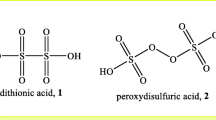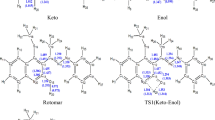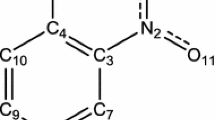Abstract
Accurate calculation of the acid dissociation constant (pKa) has fundamental importance for the description of molecular systems with pharmacological activities. The search for a more appropriate procedure for its determination is always welcome and has aroused increasing interest from the scientific community. In this sense, this work presents a computational study involving the combination of ten DFT functionals (M062X, M06L, B3LYP, BLYP, PBEPBE, BP86, LC-BLYP, SPBE, CAM-B3LYP, LC-PBEPBE) and HF method, eight basis set functions (6-311G, 6-311 + G, 6-311G(d,p), 6-311 + G(d,p), 6-311+ +G(d,p), 6-311(2d,2p), 6-311+ +G(2d,2p), and aug-cc-pVDZ), and three solvation models (SMD, PCM, and CPCM) for an accurate sulfachloropyridazine (SCR) pKa determination. It was found that the smallest deviation (0.02 unit of pKa) between the current study and experimental result was achieved with the BLYP/6-311 + G(d,p)/PCM combination. Therefore, this combination was extended to calculate the pKa of six SCR similar molecules selected through the eletroshape similarity method. For all these molecules, the difference between the obtained results and experimental data ranged between 0.14 and 0.69 units of pKa. This feature suggests that the obtained combination can determine pKa with experimental precision for complexes that are formed by sulfonamide functional group (SO2NHR).

A computational study involving the combination of different levels of theory, basis sets and solvation models for an accurate sulfanamide pKa determination.







Similar content being viewed by others
References
Issa N, Wathieu H, Ojo A, W Byers S, Dakshanamurthy S (2017) Drug metabolism in preclinical drug development: a survey of the discovery process, toxicology, and computational tools. Curr Drug Metab 18:556–565
Duffy BC, Zhu L, Decornez H, Kitchen DB (2012) Early phase drug discovery: cheminformatics and computational techniques in identifying lead series. Bioorg Med Chem 20:5324–5342
Kairys V, Baranauskiene L, Kazlauskiene M, Matulis D, Kazlauskas E (2019) Binding affinity in drug design: experimental and computational techniques. Expert Opin Drug Discov 14:755–768
Yuan Q, Gao J, Wu D, Zhang S, Mamitsuka H, Zhu S (2016) DrugE-Rank: improving drug–target interaction prediction of new candidate drugs or targets by ensemble learning to rank. Bioinformatics 32:i18–i27
Chen X, Zhu L, Li R, Pang L, Zhu S, Ma J, Jin Y (2020) Electroporation-enhanced transdermal drug delivery: Effects of logP, pKa, solubility and penetration time. Eur J Pharm Sci 151:105410
Martin YC (2018) Experimental and pKa prediction aspects of tautomerism of drug-like molecules. Drug Discov Today Technol 27:59–64
Mansouri K, Cariello NF, Korotcov A, Tkachenko V, Grulke CM, Sprankle CS, Williams AJ (2019) Open-source, QSAR models for pKa prediction using multiple machine learning approaches. J Cheminformatics 11:1–20
Peiris C, Gunatilake SR, Mlsna TE, Mohan D, Vithanage M (2017) Biochar based removal of antibiotic sulfonamides and tetracyclines in aquatic environments: a critical review. Bioresour Technol 246:150–159
Lau CHF, van Engelen K, Gordon S, Renaud J, Topp E (2017) Novel antibiotic resistance determinants from agricultural soil exposed to antibiotics widely used in human medicine and animal farming. Appl Environ Microbiol 83:e00989
Hasan TH, Al-Harmoosh RA (2020) Mechanisms of antibiotics resistance in bacteria. Syst Rev Pharm 11:817–823
Thapa B, Raghavachari K (2019) Accurate pKa evaluations for complex bio-organic molecules in aqueous media. J Chem Theory Comput 15:6025–6035
Dutra FR, Silva CDS, Custodio R (2020) On the accuracy of the direct method to calculate pKa from electronic structure calculations. J Phys Chem A 125:65–73
Romero R, Salgado PR, Soto C, Contreras D, Melin V (2018) An experimental validated computational method for pKa determination of substituted 1,2-dihydroxybenzenes. Front Chem 6:208
Martin YC (2018) Experimental and pKa prediction aspects of tautomerism of drug-like molecules. Drug Discov Today Technol 27:59–64
Thapa B, Schlegel HB (2016) Density functional theory calculation of pKa’s of thiols in aqueous solution using explicit water molecules and the polarizable continuum model. J Phys Chem A 120:5726–5735
Song D, Sun H, Jiang X, Kong F, Qiang Z, Zhang A, Qu J (2018) Determination of pKa and the corresponding structures of quinclorac using combined experimental and theoretical approaches. J Mol Struct 1152:53–60
Babkin VA, Kozhukhova AV, Andreev DS, Ignatov AV, Rakhimov AI, Rakhimova NA, Prochukhan KY (2019) Quantum-chemical calculation of some molecules of triftoromethylstyroles by the DFT method. Fluor Notes 2:5–6
Zhao Y, Truhlar DG (2008) The M06 suite of density functionals for main group thermochemistry, thermochemical kinetics, noncovalent interactions, excited states, and transition elements: two new functionals and systematic testing of four M06-class functionals and 12 other functionals. Theor Chem Acc 120:215–241
Verma P, Truhlar DG (2020) Status and challenges of density functional theory. Trends Chem 2:302–318
Raghavachari K, Trucks GW (1989) Highly correlated systems, Excitation energies of first row transition metals Sc–Cu. J Chem Phys 91:1062–1065
Domenichini G, von Rudorff GF, von Lilienfeld OA (2020) Effects of perturbation order and basis set on alchemical predictions. J Chem Phys 153:144118
Ando S (2018) Efficient hybrid functional and basis set functions for DFT calculation of refractive indices and abbe numbers of organic compounds. Chem Lett 47:1494–1497
Soriano-Correa C, Barrientos-Salcedo C, Francisco-Marquez M, Sainz-Díaz C. I. (2018) Computational study of substituent effects on the acidity, toxicity and chemical reactivity of bacteriostatic sulfonamides. J Mol Graphics Model 81:116–124
Garcia-Ratés M., Neese F (2020) Effect of the solute cavity on the solvation energy and its derivatives within the framework of the gaussian charge scheme. J Comput Chem 41:922–939
Roese SN, Heintz JD, Uzat CB, Schmidt AJ, Margulis GV, Sabatino SJ, Paluch AS (2020) Assessment of the SM12, SM8, and SMD solvation models for predicting limiting activity coefficients at 298.15 K. Processes 8:623
Skyner RE, McDonagh JL, Groom CR, Van Mourik T, Mitchell JBO (2015) A review of methods for the calculation of solution free energies and the modelling of systems in solution. Phys Chem Chem Phys 17:6174–6191
Perdew JP, Burke K, Ernzerhof M (1996) Generalized gradient approximation made simple. Phys Rev Lett 77:3865–3868
Becke AD (1988) Density-functional exchange-energy approximation with correct asymptotic behavior. Phys Rev A 38:3098
Miehlich B, Savin A, Stoll H, Preuss H (1989) Results obtained with the correlation energy density functionals of Becke and Lee, Yang and Parr. Chem Phys Lett 157:200–206
Perdew JP (1986) Density-functional approximation for the correlation energy of the inhomogeneous electron gas. Phys Rev B 33:8822
Dorner F, Sukurma Z, Dellago C, Kresse G (2018) Melting Si: beyond density functional theory. Phys Rev Lett 121:195701
Swart M (2013) A new family of hybrid density functionals. Chem Phys Lett 580:166–171
Paier J, Marsman M, Kresse G (2007) Why does the B3LYP hybrid functional fail for metals?. J Chem Phys 127:024103
Walker M, Harvey AJ, Sen A, Dessent CE (2013) Performance of M06, M06-2X, and M06-HF density functionals for conformationally flexible anionic clusters: M06 functionals perform better than B3LYP for a model system with dispersion and ionic hydrogen-bonding interactions. J Phys Chem A 117:12590–12600
Nazarian D, Ganesh P, Sholl DS (2015) Benchmarking density functional theory predictions of framework structures and properties in a chemically diverse test set of metal–organic frameworks. J Mater Chem A 3:22432–22440
Byun YM, Ullrich CA (2017) Assessment of long-range-corrected exchange-correlation kernels for solids: Accurate exciton binding energies via an empirically scaled bootstrap kernel. Phys Rev B 95:205136
Ryczko K, Strubbe DA, Tamblyn I (2019) Deep learning and density-functional theory. Phys Rev A 100:022512
Iron MA (2017) Evaluation of the factors impacting the accuracy of 13C NMR chemical shift predictions using density functional theory, the advantage of long-range corrected functionals. J Chem Theory Comput 13:5798–5819
Asnaashari Eivari H, Ghasemi SA (2019) Comparison between PBE and HSE06 functionals for the calculation of electronic band-structure of TiO2. J Res Many-Body Syst 9:1–15
Jacquemin D, Perpète E. A., Scalmani G, Frisch MJ, Kobayashi R, Adamo C (2007) Assessment of the efficiency of long-range corrected functionals for some properties of large compounds. J Chem Phys 126:144105
Lehtola S (2019) A review on non-relativistic, fully numerical electronic structure calculations on atoms and diatomic molecules. Int J Quant Chem 119:e25968
Shiozaki T (2018) BAGEL: Brilliantly advanced general electronic-structure library. Wiley Interdiscip Rev Comput Mol Sci 8:e1331
Lehtola S, Blockhuys F, Van Alsenoy C (2020) An overview of self-consistent field calculations within finite basis sets. Molecules 25:1218
Clark T, Chandrasekhar J, Spitznagel GW, Schleyer PVR (1983) Efficient diffuse function-augmented basis sets for anion calculations, III, The 3-21+ G basis set for first-row elements, Li–F. J Comput Chem 4:294–301
Curtiss LA, McGrath MP, Blaudeau JP, Davis NE, Binning Jr RC, Radom L (1995) Extension of Gaussian-2 theory to molecules containing third-row atoms Ga–Kr. J Chem Phys 103:6104–6113
Frisch MJ, Pople JA, Binkley JS (1984) Self-consistent molecular orbital methods 25, Supplementary functions for Gaussian basis sets. J Chem Phys 80:3265–3269
Scalmani G, Frisch MJ (2010) Continuous surface charge polarizable continuum models of solvation, I, General formalism. J Chem Phys 132:114110
Herbert JM (2021) Dielectric continuum methods for quantum chemistry. Wiley Interdiscip Rev Computat Mol Sci 11:e1519
Cossi M, Rega N, Scalmani G, Barone V (2003) Energies, structures, and electronic properties of molecules in solution with the C-PCM solvation model. J Comput Chem 24:669–681
Rathore PKS, Shukla SK (2021) Enhanced thermophysical properties of organic PCM through shape stabilization for thermal energy storage in buildings: A state of the art review. Energy Build 236:110799
Marenich AV, Cramer CJ, Truhlar DG (2009) Universal solvation model based on solute electron density and on a continuum model of the solvent defined by the bulk dielectric constant and atomic surface tensions. J Phys Chem B 113:6378–6396
Trucks GW, Schlegel HB, Scuseria GE, Robb MA, Cheeseman JR, Scalmani G, Barone V, Mennucci B, Petersson GA, Nakatsuji H et al (2009) Gaussian 09, Revision A, Wallingford CT
Kim S, Chen J, Cheng T, Gindulyte A, He J, He S, Bolton EE (2021) PubChem in 2021: new data content and improved web interfaces. Nucleic Acids Res 49(D1):D1388–D1395
Kumar A, Zhang KY (2018) Advances in the development of shape similarity methods and their application in drug discovery. Front Chem 6:315
Maggiora G, Vogt M, Stumpfe D, Bajorath J (2014) Molecular similarity in medicinal chemistry: miniperspective. J Med Chem 57:3186–3204
Pearson RG (2005) Chemical hardness and density functional theory. J Chem Sci 117:369–377
de Souza TNV, de Carvalho SML, Vieira MGA, da Silva MGC, Brasil DDSB (2018) Adsorption of basic dyes onto activated carbon: experimental and theoretical investigation of chemical reactivity of basic dyes using DFT-based descriptors. Appl Surf Sci 448:662–670
Pegu D, Deb J, Van Alsenoy C, Sarkar U (2017) Theoretical investigation of electronic, vibrational, and nonlinear optical properties of 4-fluoro-4-hydroxybenzophenone. Spectrosc Lett 50:232–243
Acknowledgements
The authors gratefully acknowledge the financial support from the Brazilian Research Councils: CAPES, CNPq, and FAPDF.
Funding
Financial support from the Brazilian agencies: CAPES, FAPDF, and CNPq.
Author information
Authors and Affiliations
Corresponding author
Ethics declarations
Consent for publication
The authors authorize the publication of the manuscript in the Journal of Molecular Modeling.
Conflict of interest
The authors declare no competing interests.
Additional information
Supplementary information
The online version contains supplementary material available at https://doi.org/10.1007/s00894-021-04851-9.
Author contribution
All the authors participated in the conception of the study, in the discussion of the obtained results, and in the writing. F. M. C. and Y. A. O. S. performed all the calculations. All the authors read and approved the final version of the manuscript.
Availability of data and material
Data and materials are available in Supplementary Material.
Publisher’s note
Springer Nature remains neutral with regard to jurisdictional claims in published maps and institutional affiliations.
This paper belongs to the Topical Collection VIII Symposium on Electronic Structure and Molecular Dynamics – VIII SeedMol
Electronic supplementary material
Below is the link to the electronic supplementary material.
Rights and permissions
About this article
Cite this article
Carvalho, F.M., Só, Y.A.d.O., Wernik, A.S.K. et al. Accurate acid dissociation constant (pKa) calculation for the sulfachloropyridazine and similar molecules. J Mol Model 27, 233 (2021). https://doi.org/10.1007/s00894-021-04851-9
Received:
Accepted:
Published:
DOI: https://doi.org/10.1007/s00894-021-04851-9




